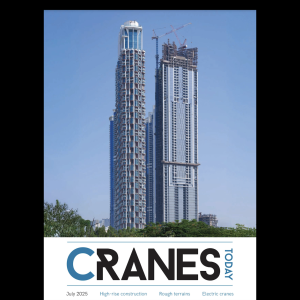With Fantuzzi-Reggiane’s manufacturing bases in northern Italy, and their involvement in the lucrative port and shipping market, it would seem a good catch at the right price. This possibility got me thinking about other precedents in the industry.
Because cranes fulfill basic material handling needs, they are used in every industrial sector: tower, mobile and crawler cranes in construction; pedestal cranes on offshore platforms (energy); dockside cranes and material handlers (transport and logistics); electric overhead travelling cranes (manufacturing and primary metals); dragline cranes (mining).
In the old days of cranes, when there was not much difference between steam shovels and crawler cranes, early machinery builders made cranes, excavators and more: Bucyrus-Erie, Pawling & Harnischfeger, Orenstein & Koppel, Demag-Zug.
The tradition of making cranes and excavators continues today with older (Liebherr) and newer (Terex) groupings. But I can only think of three manufacturers that make cranes for construction and for other industries. Sennebogen makes material handlers alongside cranes at its Straubing, Germany plant. Favelle Favco makes heavy tower cranes and offshore cranes in Malaysia. Liebherr makes offshore cranes in factories in Nenzing, Austria, container cranes in Killarney, Ireland and dockside cranes in Rostock, Germany. Have I overlooked anyone?
Perhaps for manufacturing reasons, there seem to be more companies that make both dockside and industrial cranes: there are industrial crane maker Demag Cranes & Components (which since 2006 has teamed up with Gottwald Port Technology), Russian firm Baltkran, Italian Italgru, Austrian Kuenz and the German Kirow and Kranbau Koethen.
The two largest port crane companies both hived off of Finnish elevator firm Kone. Konecranes, hived off in 1994, had EUR 1.75bn of sales in 2007 from a huge empire of acquisitions that includes industrial cranes and hoists, many different types of port cranes and dockside lifting equipment. These acquisitions include the service arm of German firm Noell, whose port crane manufacturing arm was bought by Fantuzzi. Its bigger Finnish rival, Partek Cargotec, 2007 sales in excess of EUR 3bn, collects from three diverse businesses: ship crane and port equipment maker MacGregor, port crane maker Kalmar and truck-based handling brands including Hiab loader cranes.
In 2002, Terex chose to buy only Mannesmann Dematic’s mobile crane business, leaving behind the other Demag and Gottwald Port Technology to be bought out by venture capitalist Kohlberg Kravis Roberts the same year. In 2008, will another construction crane manufacturer pass up the opportunity to buy into port and industrial cranes?






